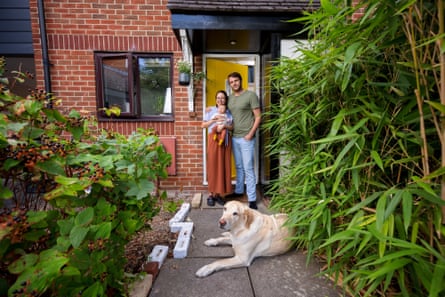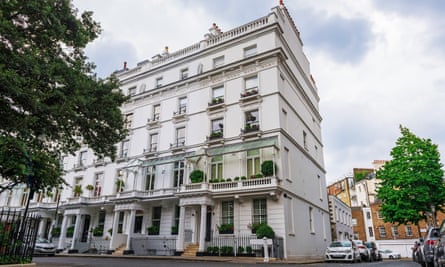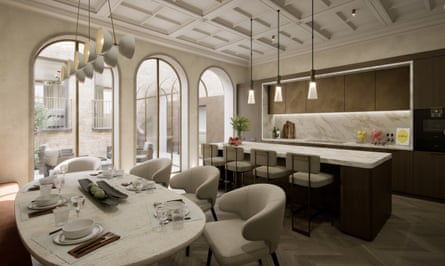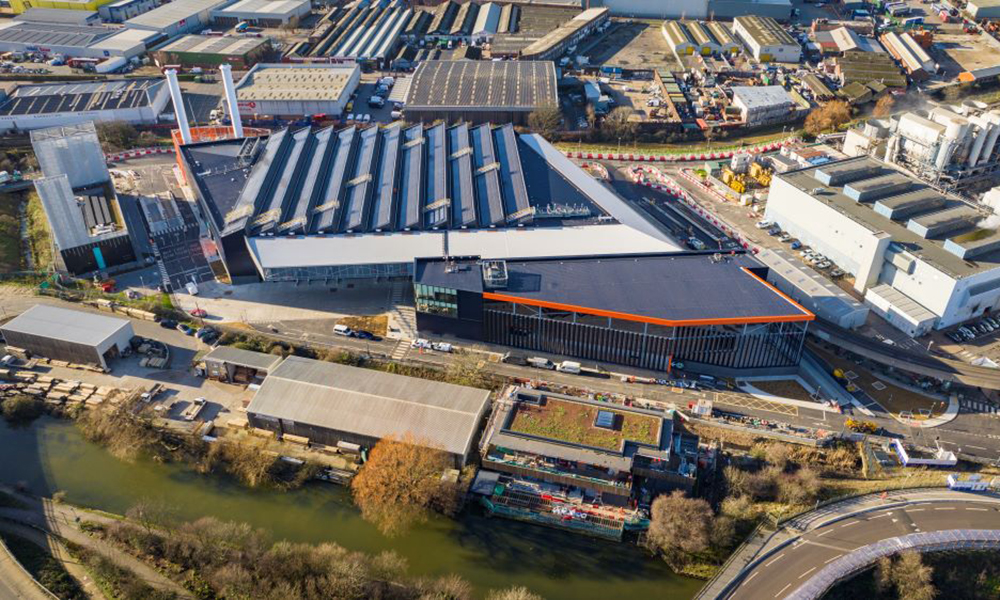
Statistics tend to define the way we think about property. As a nation, we buy and sell more than 100,000 homes a month – more than 3,000 a day. House prices went up 7.8% in the year to June 2022, taking the average property value in the UK to £286,397. The average deposit for first-time buyers is now about £75,000. People aged over 65, who represent less than a quarter of the population, own almost half of England’s housing equity.
But behind the numbers, each property transaction is a story with a cast of generally anxious characters. I set out to find properties worth £25,000, £250,000 and £25m – and speak to everyone involved in each sale and purchase. Taken together, the stories of three very different houses offer a snapshot of an industry that shapes all our lives and communities.
£25,000 – Easington Colliery, County Durham
‘When I tell my friends the prices of the properties I’m selling, they can’t believe places like this exist’
The house at the bottom of a street in Easington Colliery is in a sorry state. The windows have been boarded up, the front door padlocked shut. A rusting skip waits to be collected on the pavement. Inside, broken glass covers the carpets. Even the bannisters have been ripped out. “Requires modernisation”, the online listing had said.
A couple of weeks before my visit in August, I watch six people bid for the three-bedroom house in an online auction. Russell Taylor, the managing director of Taylor James Auctions in Birmingham, says it is unlikely that any of them has even been to Easington Colliery, a coastal former mining town between Sunderland and Hartlepool.
After 22 bids made over a few hours, the house sells for £27,000 – slightly higher than the £25,000 Taylor had predicted. “She was overjoyed,” he says of the buyer, a beauty salon owner from the Midlands (who prefers not to talk to me). The auctioneer says he sells more than 100 homes a year at about £25,000, the majority of them in County Durham, which was once the country’s leading producer of coal. He works in a rarely scrutinised sector of the market, where homes can cost less than cars, and rental yields can seem hard to resist. “When I tell my friends some of the values of the properties I’m selling, they can’t believe places like this exist,” Taylor says.
The boarded-up end-terrace house. Photograph: Christopher Thomond/The Guardian
The street is one of Easington Colliery’s A streets (their names all starting with the letter A) of terrace miners’ cottages. They were laid out in rows off Seaside Lane, a high street that was extended east of the old village of Easington after the pit was sunk in 1899. There are clusters of B and C streets, too, each built around the site of the former colliery.
Christine Wood lives a few doors up from the empty house. Her home of more than 40 years is immaculate. A painting of a pride of lions hangs above the mantelpiece, which supports porcelain figurines of siamese cats. Wood, who is 76, keeps her late husband’s miner’s lamp on a dresser. She grew up in Easington, where her father was also a miner. “It was lovely here back then,” she says. “All the miners were working and everybody cared about each other. Everyone looked after the houses and everything was clean.” She can’t remember if their rent was £2 a week or a month.
As many as 2,500 miners worked here for decades. There were two schools, a cinema and a brass brand. Easington was such an archetypal north-eastern colliery that the A streets served as the location for the 2000 film Billy Elliot. Yet the backdrop for the film – the 1984-85 miners’ strike – was the beginning of the end for the pit, starting a spiral of neglect that is still playing out on the street.
The colliery gates shut in 1993. Today, a miners’ cage lift stands as a monument on cliffs overlooking the North Sea. Mining families were offered the chance to buy their homes for £3,000. The Woods stayed put. “But anybody who could get out did get out,” says David Boyes, a driving instructor and Labour councillor for Easington Colliery. “And that left the houses prey to unscrupulous landlords.”
Boyes, who is 59 and the grandson of a miner, says several terraces have been demolished, including the streets that appeared in Billy Elliot. Other houses were sold off in lots. Taylor says landlords are now a mix of businesspeople with several properties and sometimes naive opportunists. None of them, including a Nigerian oil executive living in the US, are keen to talk. “We’ve got landlords living in Dubai, in Ireland – all over,” Boyes adds. “It’s all a bit mercenary.”
Graham (not his real name), an IT consultant from Surrey, bought the empty house more than 15 years ago as part of a batch of houses across the north-east. “It was the worst decision I ever made,” he says.
The birth of the buy-to-let mortgage in 1996 had triggered a boom, as amateurs took advantage of cheap borrowing, high rental yields and soaring property prices. Many saw property as a smarter bet than a pension. “If you had a reasonable income, you were able to borrow quite a lot with not very much scrutiny,” Graham recalls.
New landlords flocked to former mining towns. Auctions, which are standard at this level of the market, make it easy, Taylor says. “The highest bidder exchanges contracts on the day, and generally you’ll have completed within 20 working days,” he says. Spend another couple of thousand on a cheap refurbishment and find a lettings agent and you could very quickly be renting out a house for £350 a month.
But the symptoms of social deprivation are plain to see. Unemployment and crime levels are high. Wood, who has lived alone since her husband died in 2015, had to call the police after rocks were thrown at her windows. A man who answers the door next to the empty house describes the area as being “like Beirut”. He adds: “There are three problems in this area – no work, nothing going on, and drugs.”
Boyes says the town now has about 70 heroin users registered for treatment. He says many tenants flit between houses, moving on as rent demands and utility bills start to pile up. “We know for a fact that somebody’s had a leaflet in Durham prison saying if you need a house, come to Easington because it’s so cheap,” he says.
 Screengrab of a YouTube video showing the interior of the Easington Colliery house. Photograph: YouTube
Screengrab of a YouTube video showing the interior of the Easington Colliery house. Photograph: YouTube
A cycle of vandalism and vanishing tenants meant Graham collected rent for about five months in the 15 years he owned the house. “About five years ago I just decided not to spend any more money on it,” he says. He sold the house at a loss, having spent thousands on refurbishments and repairs.
Graham, who has made money on his other properties, is keen to defend landlords. “I always took the approach that if you provide good homes for people, then it’s a public service,” he says. “There are a lot of shitty landlords out there, and I’ve never wanted to be that.”
Boyes is bracing for winter as the cost of living crisis deepens. Demand at the local food bank has gone up by 350% so far this year, he says. “We’re going to protect people the best way we can.” The council has invested in more CCTV cameras and this year introduced a selective licensing scheme, which legally requires landlords to maintain standards of homes and tenants.
A community spirit still binds Easington Colliery. Last year, hundreds of villagers marched down Seaside Lane in memory of 83 men who died in a pit explosion in 1951. Most are buried in Easington Colliery cemetery, which sits next to what used to be known as the Withering Hope allotments. “Mining heritage is embedded in this community and we’re determined not to lose it,” Boyes says.
On the street, Christine Wood is waiting to see who will move into the house on the corner. She sees little evidence of the old spirit as she goes to bed alone, fearing the crime on her doorstep. She has endured extraordinary loss: her mother and brother died in a motorbike crash when she was 12. Her son died by suicide when he was 29. She has lost her husband – and her community. She would move but her own house isn’t worth much more than £25,000, which wouldn’t buy her a place anywhere else, or even pay rent for long. She says her faith is all she has left. “I do still believe God is going to step in and put the Earth right,” she says. In her lifetime? “I hope so.”
£250,000 – Didcot, Oxfordshire
‘I looked at this plain red-brick house with a tiny garden and thought: how can this be worth a quarter of a million pounds?’
When Penny Cooke stepped on to the property ladder in her 20s, she remembers it being pretty easy. She had been leafing through the local paper when she spotted some flats being built in Didcot, the Oxfordshire town where she was born and lived. It was around 1980, and she bought her flat for “about £30,000”. Average UK property prices were then about £20,000. Average wages amounted to about £4,000 a year. So the average worker could buy the average house for about five times their salary.
“I also bought the flat on a 110% mortgage, so all my moving fees were covered and I didn’t even need a deposit,” says Cooke. Her first job was at a milk bottling plant in Didcot, which was named a few years ago as, statistically speaking, the most average town in England.
Cooke, who is now 63, continued up the housing ladder. In 2002, she bought a modest red-brick semi on a cul-de-sac in Didcot that is part of a sprawling estate built on farmland during the 70s. Many of its roads have aspirational names on a royal theme: Buckingham Close; Sandringham Road; Jubilee Way.
Cooke loved the small two-bedroom house, where she lived alone, latterly with her greyhound, Honour. She added a small conservatory. But the pandemic, among other things, shifted her priorities. It was time to leave Didcot for a different pace of life on the Hebridean island of Mull.
Warren Copping, a local estate agent at Hodson’s, came to value the house last year. Cooke, who now works as a remote personal assistant, was stunned to learn it had doubled in price in less than 20 years. “I looked at this plain red-brick house with a tiny garden in Didcot and thought: ‘How can this be worth a quarter of a million pounds?’” she tells me from her new home.
Yet, at the time, £250,000 was the average house price in the UK (it has since risen to above £280,000). Average wages, meanwhile, are now a little above £30,000. So the average worker must now pay almost 10 times their salary for the average house. “I’d hate to be trying to get on the property ladder today,” says Cooke.
 Michael Harkness and Carla Martinez with Amaya, at their new house in Didcot. Photograph: Sam Frost/The Guardian
Michael Harkness and Carla Martinez with Amaya, at their new house in Didcot. Photograph: Sam Frost/The Guardian
The house also seemed expensive to Michael Harkness and Carla Martinez, who are both 29. But after sinking more money in rent than they would care to calculate since they met in 2013, the couple were desperate to buy. At one point they had been paying £1,050 a month for a one-bed flat in Brentwood, Essex – and then not much less for a room in a shared house on the edge of Reading. “It just felt a bit pointless,” Martinez says
Harkness, who is a civil engineer, was working night shifts on the motorways to try to save up. Martinez, who grew up in a modest flat in Barcelona, was doing agency shifts on top of her full-time job as an NHS care assistant. The stakes then got even higher; after getting married last year, the couple had a baby, Amaya, in June.
Almost half of first-time buyers rely on the “bank of Mum and Dad”, according to recent analysis by the estate agent Savills. “We have this absurd situation where parents are lending money to kids who can’t afford the prices the parents’ mates are charging for their homes,” says Henry Pryor, a veteran estate agent and property expert.
Beyond funds for a new fridge, neither Harkness nor Martinez had access to family money. A mortgage adviser set their maximum price at £275,000, just under the £282,000 average for first-time buyers in 2021, according to analysis by Barclays. They applied for a government help-to-buy Isa (now discontinued), which would give them an extra £3,000 towards a house worth up to £250,000 – if they could save up to £12,000 themselves.
Harkness started online searches for two-bedroom homes with good transport links not far from his workplace in Wokingham, Berkshire. Cooke’s house ticked lots of boxes, with a spare room upstairs for Amaya and space in the conservatory for a desk. They quickly made an offer.
The Isa helped with the deposit, which the couple managed to negotiate down to £20,000 – almost a third of the UK average for first-time buyers. Their mortgage payments of £840 a month are only a little higher than their previous rent. They also escaped some of the effects of soaring inflation on mortgage deals, which are now making life even tougher for first-time buyers. “Had we waited even a couple of months, it would have been a real struggle,” Harkness says. Martinez was gleeful when she got the keys. “It felt like such a big thing to have our own place.”
While it’s harder than ever to get a foot on the ladder, Copping says demand in Didcot has actually risen among first-time buyers this year, partly due to a pandemic-related exodus from London. Buy-to-let landlords have also been less active in the town. Selling to young couples rather than landlords involves a lot more work, Copping says. “But we get real satisfaction from it. They’ll forget us but we won’t forget them.”
The couple made some modest improvements (it helps that Harkness is handy) and bought a cheap barbecue for the tiny garden. Sitting in their small living room in late July, five-week-old Amaya asleep on Martinez’s lap, they are aware that they are ahead of the game. Their friends are still mainly paying ratcheting rents for rooms in shared houses, with no obvious way out. Others are leaving the south-east to move to cheaper areas in Scotland and south Wales, aware that in some cases they will unlikely be able to afford to return. “It’s really hard,” says Martinez.
The couple are now trying to make friends in Didcot, where they are a 20-minute walk from the high street and train station. But they feel lucky, and are naturally positive. “You have to go for what you can get and make lemonade out of lemons,” Harkness says.
£25m – Belgravia, London
‘If I were to say that refrigerated bathroom cabinets were becoming standard now, you might think I’m a little crazy’
You won’t find anything so vulgar as a “for sale” sign outside a grand house on a coveted square in Belgravia. But the owner of the property, a Scandinavian businesswoman who declined to talk but kindly let me look around, certainly wants to sell it. Just don’t even think about offering her anything less than £25m.
I’m greeted at the triple-locked front door by Simon Deen, the estate agent tasked with finding a buyer for the Grade II-listed 19th-century house. Six floors rise from the basement in a layer cake of gleaming stucco.
Deen offers me a Mini Magnum from an enormous freezer a few days after the marketing launch. It had been a hot evening, and the ice-creams had felt like a nice touch. At this level of the London “super-prime” market of £10m-plus properties, houses become brands, with their own social media accounts and expensively produced digital content. Or they’re quietly sold “off-market” – the seller’s preference in about half of such sales, Deen says.
 Yours for £25m – or more … Photograph: Ryan Prince/The Guardian
Yours for £25m – or more … Photograph: Ryan Prince/The Guardian
Either way, London’s super-prime market is buoyant. Relaxing travel restrictions and a weak pound have helped it return towards its 2015 peak, about the time the then mayor Boris Johnson boasted at a real estate conference in Mayfair: “London is to the billionaire as the jungles of Sumatra are to the orangutan. We are their natural habitat.”
There were 155 sales above £10m in the capital in the year to April 2022 – the highest number for six years, the estate agent Knight Frank reported in July. Forty-six of these transactions were above £20m. And after a slight cooling prompted by tougher planning, higher taxes, Brexit and the pandemic, foreign buyers are back in force, accounting for 80% of the latest sales (if not the Russians, although Deen says they have not been very active for years).
The leafy squares and avenues of Belgravia, which border Kensington and Chelsea, are at the heart of super-prime London. This particular house has always been home to the very rich, including naval commanders and sons of baronets.
To the casual viewer not in possession of a spare £25m (the asking price is actually £27m at the time of writing), the 10-bedroom house looks to be in excellent condition. The marble floors and stone fireplaces are buffed, the chandeliers sparkle and the basement swimming pool shimmers under a giant mural featuring a Greek temple and cedar trees.
But no major work has been completed here since the late 1990s, and Deen knows that any prospective buyer will want to bring it up to the standards of the 21st-century super-rich. He persuaded his client to wait for almost a year so that he could commission designs and get planning permission for a total refurbishment.
The owner is abroad when I visit, and personal effects have largely been stripped away, bar a few family photos and a bedside copy of Melinda Gates’s memoir, which Malala Yousafzai described as “an urgent manifesto for an equal society”. In each room, computer-generated images of the new scheme stand on easels. There’ll be a new wine cellar and a hammam, and the existing gym and cinema will switch places. There will be air-conditioning throughout and eight suites as finely finished as those of a five-star hotel. Deen estimates the work would cost at least £6m to complete.
Graham Harris, the man behind the designs, is a founding partner at SHH Architecture and Interior Design, the go-to firm for the super-rich doer-upper. His other work has included a vast mansion on Belgrave Square that at one point had an asking price of £125m (its basement swimming pool turns into a ballroom at the flick of a switch). He also masterminded the restoration of Athlone House, a neo-gothic pile on the edge of Hampstead Heath that, even in its former derelict state, cost the Russian billionaire Mikhail Fridman £65m to buy in 2016. (Harris had finished the job long before Fridman was sanctioned after Russia’s invasion of Ukraine.)
 A computer-generated image of the proposed informal dining area/orangery. Photograph: Simon Deen Real Estate
A computer-generated image of the proposed informal dining area/orangery. Photograph: Simon Deen Real Estate
Harris, who is 59 and set up his firm in 1992, says his job is to stay ahead of the mores of his “uber-prime” clients. “So if I were to say to you that refrigerated bathroom cabinets were becoming standard now, you might look at me and think I’m a little crazy,” he says. “But if you’ve got your Crème de la Mer tubs of moisturising cream at £150 a pop [for 30ml, or £1,780 for the 500ml tub], where are you going to keep them?” Harris has also recently completed several gin rooms, a 26-car basement garage and what he claims to be the largest private walk-in humidor in Europe.
This house is small by his standards at 9,000 sq ft, which is more than 10 times the UK average, but less than a quarter of the size of his biggest projects. “I always say to my clients that you can live very comfortably with 6,000 sq ft,” Harris says. “Beyond that, you’re going to kind of lose yourself.”
Deen, who is 41 and remembers drawing floor plans of his own modest home while growing up in north London, is aware that he operates in a world with a tricky reputation. Until money laundering laws tightened in 2017, buyers could hide behind offshore companies registered in tax havens. Pockets of super-prime London became stuccoed vaults for wealth of not always impeccable origin, the homes themselves often being left empty. But today, Deen says: “I know who buyers are, where they live and that the funds are legitimate … Apart from anything else, my clients want to know who they’re selling to because no one wants an issue down the line.”
Harris, who grew up in Leeds, where his father was a developer of leisure centres, says he thinks long and hard before taking on a client. “We still have a moral compass,” he says. He is hoping that whoever buys the house will proceed with his designs. Deen says interest has been high. He has a lot riding on the sale; while he is tight-lipped about his cut, a typical 2% commission would leave him with £500,000 or more. As we leave, and lock the door behind us before the next viewing, the estate agent rushes to wipe up a drip of ice-cream that has fallen on to an immaculate slab of marble flooring.
Do you have an opinion on the issues raised in this article? If you would like to submit a letter of up to 300 words to be considered for publication, email it to us at [email protected]
https://www.theguardian.com/money/2022/sep/27/25000-wreck-25m-home-indoor-pool-three-house-sales-modern-britain





